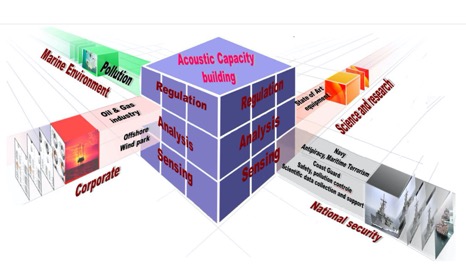Indo-Pacific Strategic Space and Geo-Economics
Dr (Cdr) Arnab Das offers a new perspective based on the Underwater Domain Awareness (UDA) Framework in the Indian Ocean Region (IOR)
The 1970s saw a new international order and US foreign policy faced unprecedented challenges in coping with the changed geopolitical scenario. Economies could no longer be independent of the geopolitical realities and thus came the term International Political Economy (IPE). The founders of IPE recognized the importance of the economy in the analysis of an international order, in view of the perception that the nation-state as a global actor was in relative decline. The creation of GATT and IMF reflect the increasing economic interdependence, since protectionist practices gave rise to liberal competition. In other words, the interstate disputes started focussing on technical rather that security issues. It is interesting to note that such an increase in interdependence was an intensifying factor for international conflicts as well.
Experts differ on what IPE stands for, as there are multiple links between economics and international relations. Though the relationship among disciplinary groups is one of power, the term geo-economics pertains to the dialogue between political and economic imperatives of the international system, given the IPE framework. Thus, the broad understanding of geo-economics is the use of economic instruments to promote and defend national interests, as well as to generate beneficial geopolitical results. It is clearly seen that a security centric approach has far less relevance in the international system today, and economics has become a more critical instrument of global power play.
The strategic discourse has decisively shifted to the maritime domain in the 21st century, and increasingly more and more nations have started joining the Indo-Pacific Strategic Space. Every global power is maintaining its strategic presence in the Indo-Pacific region and more and more assets are being deployed both militarily and otherwise. The formation of QUAD (The Quadrilateral Security Group) is a reflection of this power struggle in the region to dominate the maritime space. The switching between economic sanctions and military action is a reflection of the complexity of the geo-economic power game. Thus, geo-economics needs to be a matter of deep research and strategic interaction among the policy makers at the national, regional and global level.
The Indo-Pacific Strategic Space has some unique characteristics that need to be analysed before looking at the geo-economic dimensions. The region comprises the tropical littoral waters of the Indian Ocean and the Pacific Ocean. Tropical littoral waters have specific challenges of sonar performance for any acoustic survey deployments. The degradation of performance is of the order of 70%, making most of the hardware imported from the West near redundant in these waters. The socio-economic realities of the region make it extremely difficult for the leadership to prioritise Science & Technology (S&T) over several other budgetary requirements. Indigenous capacity and capability is a causality, whereas the local site specific R&D is the only way forward. The political volatility ensures fragmented geopolitics within the region and also among the stakeholders within nations. Extra-regional powers are able to meddle in the domestic politics to ensure poor governance. The worst outcome of this chaos is that the Indian Ocean Region (IOR) has maximum spending on military hardware, whereas nations in the region are still struggling with basic socio-economic necessities. In the absence of field experimental R&D efforts to develop indigenous acoustic software, the hardware has minimal efficacy due to severe medium distortions.
Maritime Domain Awareness (MDA) is the key for enhanced maritime governance. The MDA effort globally got a major boost post the 9/11 incident, when US policy makers made it a part of their strategic vision. Massive infrastructure investments and capacity building were undertaken to enhance the MDA. In the IOR, post the 26/11 terrorist attacks, the MDA efforts led by the Indian Navy became a major priority area. However, the MDA effort had two critical limitations. The first is that being an event driven formulation, it lacked comprehensive and sustained capacity and capability building. The second, and more important, limitation was that it remained a security centric formulation with minimal participation by the other stakeholders. The defence budget alone can never drive such a massive strategic exercise with enormous resource requirement. The MDA effort, even in the US, has been criticised for its focus on the surface; the underwater component of the MDA is highly inadequate.
The Underwater Domain Awareness (UDA) Framework proposed by the Maritime Research Centre (MRC) encourages pooling of resources and synergizing of efforts across all the four stakeholders: maritime security, blue economy, marine environment & disaster management, and science & technology. The S&T driven UDA framework with significant emphasis on local site specific field experimental R&D is the only way forward in the tropical littoral waters. Fig. 1 presents a comprehensive perspective of the UDA framework. The underlying requirement for all the stakeholders is to be aware of the developments in the undersea domain, make sense of these developments, and then respond effectively and efficiently to them before they take the shape of an event.

The UDA needs to be comprehensively understood in its horizontal and vertical construct. The horizontal construct would be the resource availability in terms of technology, infrastructure, capability and capacity specific to the stakeholders or otherwise. The stakeholders represented by the four faces of the cube will have their specific requirements, however the core will remain the acoustic capacity and capability. The vertical construct is the hierarchy of establishing a comprehensive UDA. The first level or the ground level would be the sensing of the undersea domain for threats, resources and activities. The second level would focus on making sense of the data generated to plan security strategies, conservation plans and resource utilization plans. The next level would be to formulate and monitor a regulatory framework at the local, national and global level.
The figure above gives a comprehensive way forward for the stakeholders to engage and interact. The individual cubes represent specific aspects that need to be addressed. The User-Academia-Industry partnership can be seamlessly formulated based on the user requirement, academic inputs and the industry interface represented by the specific cube. It will enable a more focused approach and well defined interactive framework. Given the appropriate impetus, the UDA framework can address multiple challenges being faced by the nations in the IOR and South China Sea (SCS) today. Meaningful engagement of the young students and professionals within the nation, and diplomatic engagements across the region are probably focus areas deserving most attention. Multi-disciplinary and multi-functional entities can interact and contribute to seamlessly synergize their efforts towards a larger goal. To be credible geo-economic players in the Indo-Pacific, nations have to focus on acoustic capacity and capability building; otherwise, the extra-regional players will continue to exploit the region for their narrow strategic interests. Our own strategic interest means a safe, secure, sustainable growth model.
In the IOR, specific to the Indo-Pacific strategic construct, the UDA does have a major role to play. The Indo in the Indo-Pacific will mean that India needs to play a dominant role in the IOR and that may pitch India in direct confrontation with the Chinese. Given the proliferation of submarines (both conventional as well as strategic) in the navies of the region, underwater dominance may become the key to strategic dominance. The indulgence of non-state actors further complicates matters, with asymmetric advantage always with the subversive elements. Special efforts are required to overcome the site-specific physical challenges and acoustic capability and capacity building deserves immediate and massive initiatives. The socio-economic and socio-political status in the region does not allow massive military investments for the political leadership trying to balance competing socio-economic demands. Thus pooling of resources and synergizing of efforts across stakeholders is the only way forward.
Developing nations have their own challenges of resource limitations, leadership crisis, technology challenges, governance issues of coordination among stakeholders, and more. A systematic and comprehensive strategic way forward will go a long way. The UDA framework as proposed by MRC is not a mere underwater extension of the MDA concept, but comprehensively addresses the Safe, Secure, Sustainable Growth model critically required for the IOR to overcome the economic, political and physical challenges of the region. It is a very broad framework that will require far more detailing to address the finer points in a holistic manner. IPE and geo-economics will have to be understood and addressed effectively.

Dr. (Cdr.) Arnab Das
About Author
Dr (Cdr) Arnab Das is Founder & Director, Maritime Research Centre (MRC), Pune.


